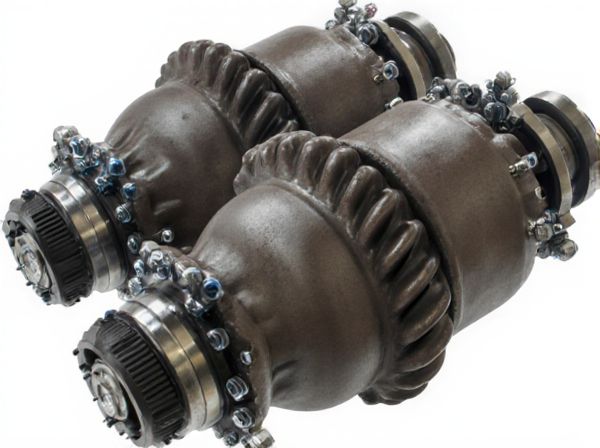
Photo illustration: Passive Locking Differential vs Active Locking Differential
A passive locking differential automatically engages when one wheel loses traction, distributing power to the wheel with grip without requiring input from you. In contrast, an active locking differential uses sensors and electronics to detect wheel slip and proactively control power distribution for improved performance on challenging terrains. Choosing between the two depends on your vehicle's intended use, with passive systems favored for simplicity and active systems delivering superior traction control.
Table of Comparison
| Feature | Passive Locking Differential | Active Locking Differential |
|---|---|---|
| Operation | Automatically locks when slip is detected | Electronically controlled locking on demand |
| Control Method | Mechanical, no driver input required | Driver or ECU controlled via electronics |
| Performance | Limited to mechanical grip, less versatile | Enhanced traction control, adaptable to conditions |
| Reliability | High durability, fewer parts | More complex, potential for electronic failure |
| Maintenance | Low maintenance, simple design | Requires electronic diagnostics and upkeep |
| Cost | Lower initial cost | Higher cost due to advanced technology |
| Applications | Common in off-road and utility vehicles | Used in modern performance and all-terrain vehicles |
Introduction to Locking Differentials
Locking differentials enhance vehicle traction by ensuring both wheels on an axle rotate together, improving off-road and low-traction performance. Passive locking differentials engage automatically when a difference in wheel speed is detected, offering simplicity and reliability without driver intervention. Active locking differentials use electronic controls and sensors to lock or unlock the differential based on driving conditions, providing precise traction management and improved vehicle stability.
What is a Passive Locking Differential?
A Passive Locking Differential automatically distributes torque between wheels on an axle without driver intervention, using internal mechanisms like clutch plates or gears that engage when slip is detected. Unlike Active Locking Differentials, which rely on electronic controls and sensors to lock or unlock the differential, Passive systems respond mechanically to traction changes. This design enhances off-road capability by improving grip on uneven surfaces while maintaining smooth operation during normal driving conditions.
How Passive Locking Differentials Work
Passive locking differentials operate by automatically engaging when a difference in wheel speed is detected, using mechanical components like clutch packs or gears to limit slip between wheels. They distribute torque to the wheel with more traction without driver intervention, enhancing vehicle stability on uneven or slippery surfaces. This system contrasts with active locking differentials, which use electronic controls to optimize torque distribution dynamically.
What is an Active Locking Differential?
An active locking differential uses electronic sensors and actuators to automatically engage and disengage the locking mechanism based on real-time driving conditions, improving traction on slippery or uneven terrain. Unlike passive locking differentials, which lock mechanically under certain conditions, active systems receive input from wheel speed sensors to detect wheel slip and apply torque to the wheel with more grip. This dynamic control enhances vehicle stability, off-road capability, and overall drivetrain efficiency.
How Active Locking Differentials Work
Active locking differentials operate by using electronic sensors and actuators to monitor wheel speed and torque distribution, allowing precise engagement of the locking mechanism when wheel slip is detected. Unlike passive locking differentials, which rely on mechanical forces and traction differences, active systems dynamically adjust power delivery in real time for enhanced traction and stability. This technology improves off-road performance and handling by automatically locking the differential when needed and unlocking it during normal driving conditions to prevent drivetrain binding.
Key Differences: Passive vs Active Lockers
Passive locking differentials automatically engage when wheel slip is detected, using mechanical components like clutch packs or gears to distribute torque evenly between wheels. Active locking differentials employ electronic controls and sensors to selectively lock or modulate torque delivery based on driving conditions, offering enhanced traction and adaptability. The key difference lies in passive lockers' reliance on mechanical action versus active lockers' dynamic control systems for improved performance.
Performance Comparison in Off-Road Conditions
Passive locking differentials rely on mechanical design to distribute torque evenly to both wheels, providing consistent traction on uneven terrain without electronic intervention. Active locking differentials use sensors and actuators to engage or disengage the lock based on wheel slip, offering improved adaptability and enhanced control over a wider range of off-road conditions. Performance-wise, active locking differentials often deliver superior traction and stability on varied, challenging surfaces, while passive systems excel in reliability and simplicity under consistent off-road loads.
Durability and Maintenance Considerations
Passive locking differentials rely on mechanical components such as gears and clutches that engage automatically under specific conditions, offering high durability with minimal maintenance due to their simpler design. Active locking differentials incorporate electronic or hydraulic controls, which provide superior traction but require more frequent maintenance checks and component replacements to ensure reliable performance over time. Durability in passive systems often surpasses active types under harsh conditions, while active differentials offer enhanced functionality with a trade-off in increased maintenance demands.
Cost Analysis: Passive vs Active Lockers
Passive locking differentials generally offer a lower upfront cost and reduced maintenance expenses due to their simpler mechanical design, making them an economical choice for standard off-road and everyday use. Active locking differentials, equipped with electronic or hydraulic controls, incur higher initial investment and potential repair costs but provide superior traction and performance in challenging terrains. Evaluating the cost-benefit balance depends on vehicle application and the user's need for advanced traction control versus budget constraints.
Which Locking Differential is Right for You?
Choosing between a passive locking differential and an active locking differential depends on your driving needs and terrain. Passive locking differentials automatically engage when wheel slip is detected, offering simplicity and reliability for off-road enthusiasts or those encountering moderate challenges. Active locking differentials require manual or electronic activation, providing maximum control and traction for extreme off-road conditions or performance driving.
 caratoz.com
caratoz.com